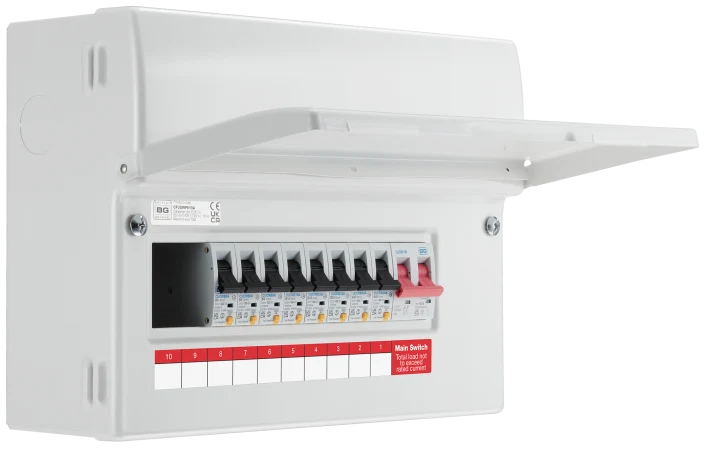The Role of Consumer Units in Reliable Power Administration Solution
Customer units are indispensable to reliable power management systems, offering as the primary circulation points for electric power within structures. The introduction of smart innovations has even more improved their functionality, enabling for real-time information tracking and nuanced energy intake analysis.
Comprehending Customer Units
-1796-p.jpg?v=293b7e83-9afe-44ed-b26f-caca2c71d6f2)
Comprehending the function of consumer devices begins with recognizing their essential function in safeguarding electrical systems. By isolating mistakes within particular circuits, consumer units avoid extensive outages and possible fire threats. This isolation is attained through making use of circuit breakers that trip or fuses that impact when a fault is found, thus removing the electric circulation to the affected circuit.
Furthermore, consumer systems facilitate the orderly distribution of power, improving the efficiency of power use. They permit the methodical monitoring of electric loads, which can be especially crucial in business and commercial settings where need can rise and fall significantly. Properly conserved customer units add to the long life of electrical systems and aid in decreasing downtime created by electrical failures, eventually sustaining the seamless procedure of energy-dependent centers.
Smart Technologies Assimilation

A crucial advantage of smart consumer devices is their capacity to take advantage of advanced algorithms and maker understanding for predictive analytics. This permits preemptive changes based upon use patterns, weather prediction, and other variables, considerably increasing overall effectiveness. Moreover, wise consumer systems help with need reaction programs, where power use can be dynamically readjusted throughout optimal periods to stabilize the grid and decrease prices.
The combination of renewable resource sources, such as solar and wind, is additionally streamlined via wise customer systems. By intelligently managing the intermittency of these sources, these units guarantee a reputable and balanced power supply. In addition, smart consumer devices improve customer involvement by offering in-depth insights and remote control capabilities via mobile applications, promoting an extra aggressive strategy to power preservation and sustainability.
Tracking Energy Intake
Building on the abilities of smart innovations assimilation, checking energy intake ends up being a critical focus within energy administration systems. By leveraging innovative metering facilities (AMI), real-time data on energy use can be gathered at granular levels, giving important insights into intake patterns and peak need durations.
Smart meters and Web of Things (IoT) gadgets play a critical function in this tracking procedure. These gadgets can track energy use in real-time, sending information to centralized systems for evaluation. The gathered data is after that processed via sophisticated formulas to spot anomalies, forecast future intake, and suggest optimization approaches. In addition, cloud-based options offer scalable platforms for keeping and evaluating large datasets, promoting remote surveillance and control.
The integration of these modern technologies not just encourages consumers with in-depth information concerning their power usage yet additionally sustains utility providers in taking care of lots distribution extra properly. Eventually, precise and continuous monitoring is crucial for achieving energy effectiveness, expense financial savings, and sustainability objectives within energy management systems.
Optimizing Home Appliance Use

One effective approach entails identifying top and off-peak hours to you could try here change energy-intensive activities, such as washing or dishwashing, to times when power need is lower. This not just lessens strain on the grid yet additionally maximizes lower power tolls. In addition, incorporating artificial intelligence algorithms permits anticipating upkeep, ensuring home appliances operate at optimum performance and prolonging their life expectancy.
Power management systems can additionally incorporate user-specific choices and habits to customize home appliance usage schedules. For instance, clever illumination systems can readjust illumination based upon occupancy and natural light accessibility, while cooling and heating systems can maintain convenience degrees without excessive energy usage.
Encouraging Sustainability
Promoting sustainability within power monitoring systems involves not only improving performance but additionally cultivating environmentally responsible methods. Customer systems are important to this process, as they offer real-time data and control devices that enable users to keep an eye on and reduce their energy intake. By leveraging sophisticated modern technologies, consumer devices can recognize energy-saving chances and facilitate the assimilation of renewable power resources like solar and wind power.
One important facet of promoting sustainability is informing customers on the benefits of liable power usage. With comprehensive understandings offered by consumer devices, customers can make enlightened choices that reduce their carbon footprint. As an example, these systems can advise ideal times for operating high-energy home appliances based upon grid demand and renewable resource availability, therefore minimizing dependence on fossil fuels.
Additionally, consumer systems support check the fostering of clever grid innovations, which enhance the overall efficiency and integrity of power distribution. By making it possible for two-way communication between customers and energy suppliers, these systems can dynamically get used to power demands, lowering waste and advertising making use of sustainable power methods.
Final Thought
Customer systems, as indispensable components of power management systems, browse around these guys significantly boost electrical security and efficiency within structures via circuit protection and clever technology integration. In addition, the incorporation of sustainable power resources advertises sustainable techniques, contributing to minimized total energy consumption and lower carbon footprints.
Breakthroughs in clever technologies have actually reinvented the capacities of energy management systems, particularly via the assimilation of smart consumer systems.Structure on the capabilities of smart technologies integration, monitoring power usage becomes an essential emphasis within power monitoring systems.Reliable home appliance use optimization is an essential part of power management systems, intending to enhance performance and lower unneeded energy intake.Customer units, as essential components of power monitoring systems, significantly boost electrical safety and efficiency within structures with circuit defense and smart modern technology combination. Furthermore, the incorporation of sustainable energy resources advertises lasting techniques, contributing to minimized general energy usage and reduced carbon impacts.